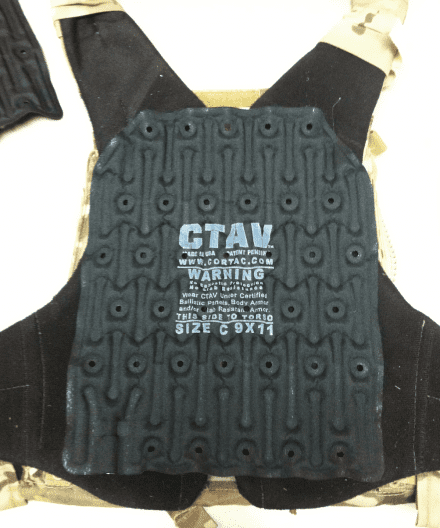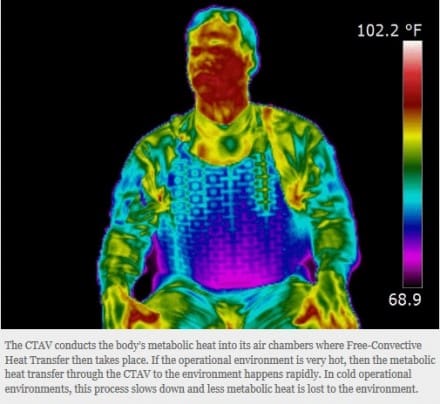I have been talking to the CORTAC guys for a while now and this is pretty big news for them. They’ve got an interesting technology and I can’t wait to see what Safariland has in store for their system.
May 14, 2014 – HENDERSONVILLE, Tenn. – CORTAC announces they have secured an exclusive distribution and OEM integration agreement with The Safariland Group, the manufacturers of Second Chance®, ABA® and Protech Tactical® brands of body armor. The agreement grants The Safariland Group exclusive CTAV OEM integration into armor carrier systems and CTAV Retrofit Kit™ and Shirt Carrier System (SCS)™ distribution rights for the United States Law Enforcement market, both state and local.
The CTAV combines the power of Advanced Impact Resistance technology (AIR)™ and the science of EverDryTM to significantly enhance the comfort of wearing concealable vests, outer vest carriers and tactical body armor, while also providing an additional layer of protection from ballistic and non-ballistic blunt trauma.
“The CTAV is a proven technology that will have a huge impact in the body armor market. CORTAC has solved the age-old problem of excessive body heat being trapped between armor and the body. Officers are often in adverse conditions such as extreme heat so the CTAV really is a game changer when it comes to comfort. We are very excited to partner with CORTAC to offer this technology to our customers,” said Todd Mackler, The Safariland Group Vice President of Armor.
“We are excited that The Safariland Group will be co-branding and providing sales and distribution for the United States Law Enforcement sector,” said Mike Letterman, CEO of CORTAC. “Their distribution system, combined with our CTAV product line, significantly strengthens our mutual ability to put the CTAV into the hands of law enforcement and corrections personnel, where it is greatly needed.” Letterman also added, “This paves the way for The Safariland Group and CORTAC to work closely on other military and international projects.”
Tags: CORTAC, Safariland




It doesn’t work according to the following article:
“When participants exercised with either a military protective vest or a law enforcement concealable vest while wearing the spacer garment, there were no thermoregulatory differences when compared to control trials. Thus, the passive spacer garment had no effect on the physiological responses during mild exercise in the heat.”
Read the whole article for yourself:
http://www.dtic.mil/dtic/tr/fulltext/u2/a477047.pdf
that study is 7 years old
That doesn’t mean it is irrelevant. Can you supply us with recent research of the CORTAC products (or similar)? I would be very interested in the results.
it doesn’t mean its irrelevant, but it doesn’t necessarily mean its still valid either. no i can’t supply you with research, i’m here to tell you that a 7 year old study is at this point irrelevant and needs updating
Why would you suggest it is irrelevant, are the research methods wrong? Is it a different product being researched?
Just to be clear, I am not trying to argue here. I am just curious what you suggest that should be updated.
irrelevant was your word, not mine. you’re trying to discredit a brand new product with a 7 year old study. my point is that its time to take another look, not say “oh well this study from 7 years ago said it didnt work so obviously nothing can change in 7 years.”
I am simply stating the article. That is not my personal opinion or observation nor am I trying to discredit this product.
The article questions the thermoregulatory effectiveness of a spacer garment. The research has been done by the US Army Research Center, which is, in my opinion, a reputable organisation.
What would you suggest has changed since 7 years? Was it a different product which has been tested in 2007?
I want to stress the point that I am not trying to discredit this product or pushing an agenda. I brought this up for acedemic purposes only.
if you brought it up for academic purposes only then you should know that a 7 year old study is far to old to be considered relevant. most academics wont cite an article if its over 3 years old
I am sorry, that is not true. Would you suggest parallel to your arguments that it is time to update, for instance, Philosophiae Naturalis Principia Mathematica for Newton because it is from 1687?
Can you please state your arguments what should be updated? It is surely interesting to read research that can disprove this article.
You’re right, its actually 5 years. I’m talking academic studies, not 17th century math books.
The study is relevant unless the company has changed the product. If there is also relevant scientific data that disputes the findings of the Army report, that should also be considered. But you can’t dispute a report that is 5 or even 500 years old unless the science has changed. I don’t think we’ve changed how we measure thermal load in the past five years.
The issue here is material. This is not spacer mesh. Not at all.
Academics will most certainly cite articles over 3 years old! I have no idea from where you pulled this number, but I must disagree. I have masters in Engineering, have done graduate level research. At least in the engineering world relevance is not determined by a date, and this seems to fall under engineering. I’m making no judgement on the quality/value/results of this product, just the false “3 year old” statement.
OK bear with me as I’m off to work out but saw this when checking SSD before signing off to hit the gym. This will be quick.
Erik, The folks at Natick are top notch so you’re right about the method still being good. However there are some issues. First, this doesn’t appear to be the same vest. The one in the study is described and I put it below:
“In trial S, subjects additionally wore a
1 cm thick vest of proprietary knit fabric in between the
IBA and BDU (S: clo = 1.28, im/clo = 0.32 at wind speed
1 m/s)”
Clo is a value of thermal resistance for lay people.
Also, bear in mind that the clo value of a BDU garment is different than what is currently worn in battle. Combat shirt vs BDU blouse with T-shirt. The second provides much more thermal and evaporate resistance. It is exactly what it sounds like.
A spacer system evaporates sweat from the body, if the garment between the body and the spacer has a higher thermal and evaporation resistance, it won’t perform well.
Also, what armor you’re wearing is going to have an effect. In the study referenced, the armor is the IBA, which is approximately equal to the IOTV in coverage area (thermally) or we would call percent of Dubois Area (AD). Today plate carriers are much more in vogue and have different fit, coverage, ventilation, etc. properties than your IOTV or IBA.
So, the folks at Natick aren’t wrong, this study just necessarily apply, all systems are different.
I’m doing my PhD on similar work and have performed testing on similar applications. I can’t really speak for my org, no do I want to advertise or get my butt in a sling. SSD you can look me up via my email if you want. However, if you guys have questions I’ll answer what I can. I’ll try and remember to check this tonight.
Thanks for being informative!
I’ve had these in the shop for some time now. No one even looks at them. It’s an education thing. They are comfortable, alleviate bruising and create a standoff to promote cooling. Wearing them for hours without getting the giant wet spot is proof enough for me.
And then there’s that.
Mike,
You are correct, it is an education (and exposure) issue. Thankfully, we now have key end-users with the CTAV down range with very positive results. Let us know if we need to stop by the shop.
I saw this awhile ago when doing research. I was intrigued and figured I’d see where you guys went with it. Have you guys done the standard ASTM F2300 or F2372 tests on this yet? Just a thought.
Any experience with it using as the contact area of a backpack?
My thoughts exactly.
Been wearing mine for months now and have been very happy with it. Nice work guys and cant wait to play with it some more.
Gents, with respect to everyone’s opinion, I am currently running a CTAV with an S&S Precision plate carrier. It is the best system I have worn in 10 years of special operations. The CTAV is much more than a simple spacer and it works very well. The channelized air pockets allow heat to ventilate, and it is coated in an anti-bacterial moisture wicking material. You can visually recognize reduced sweat on your shirt and feel the ventilation, leading to less dehydration. Cortac has also conducted extensive lab studies in order to ensure the CTAV functions accordingly. Some of my buds at JSOC are running CTAVs as well. This thing works and is catching on in SOF. Most people who see my kit ask where they can get one.
There is also that…
There has definitely been an interest in this system by the SOF community. We are currently testing this in house and are looking at integrating it into our SOCS for our PlateFrame. My intention here is to get any and all opinions about the Cortac product. Good or bad.
In a word: “Don’t”
I remember seeing this. My initial comment regarding the claimed “Stand off ventilation” was: “Have you ever seen a fat person sit on a lawn chair”. And then we asked to see a thermal photo of the test subject’s temp under, it which they couldn’t produce. We did see some value in using it as a means to provide a measure of neutral buoyancy by inserting it into the carrier. Essentially it keeps your armor cool. NOT the individual wearing it.